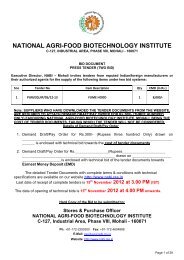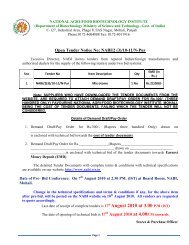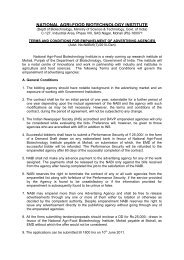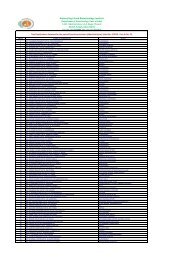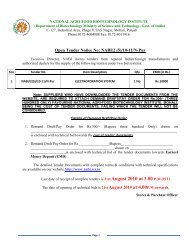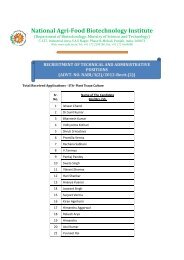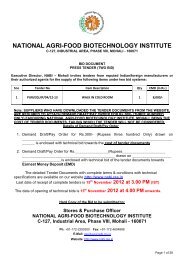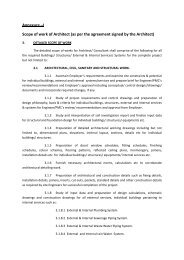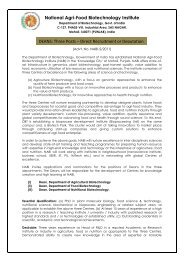Annual Report 2011-2012 - Nabi.res.in
Annual Report 2011-2012 - Nabi.res.in
Annual Report 2011-2012 - Nabi.res.in
- No tags were found...
Create successful ePaper yourself
Turn your PDF publications into a flip-book with our unique Google optimized e-Paper software.
NATIONAL AGRI-FOOD BIOTECHNOLOGY INSTITUTETable 1: List of putative phytic acid biosynthesis pathway genes regulateddur<strong>in</strong>g the anthesis <strong>in</strong> wheat plants.Probe set Gene Bank ID Annotated function(based on blast homology)Ta.27561.1.S1_at CK215630 <strong>in</strong>ositol-tetrakisphosphate 1 -k<strong>in</strong>ase 1 (from Zeamays)Ta.30464.1.A1_at CK214494 <strong>in</strong>ositol hexaphosphate k<strong>in</strong>ase (from Arabidopsis)Ta.5574.1.S1_a_at BJ227701 1-phosphatidyl<strong>in</strong>ositol-3-phosphate 5 -k<strong>in</strong>ase-like(from Oryza sativa Japonica)TaAffx.113052.1 .S1_at CA618510 <strong>in</strong>ositol-tetrakisphosphate 1 -k<strong>in</strong>ase 1 (from Zeamays)TaAffx.121326.1.S1_at CA690518 <strong>in</strong>ositol 1,3,4 -trisphosphate 5/6 -k<strong>in</strong>ase (fromOryza sativa Japonica)TaAffx.19998.1.A1_at CD867474 <strong>in</strong>ositol phosphate k<strong>in</strong>aseTaAffx.112860.1.S1_at AF532601 multidrug <strong>res</strong>istance associated like prote<strong>in</strong> :MRP2 (Zea mays: lpa-1 gene)1.2 Accelerated breed<strong>in</strong>g for qualityimprovementPr<strong>in</strong>cipal Investigator:Monika GargResearch Fellows:Rohit KumarVishal GuptaShaweta AroraIntroduction:is well known. The prote<strong>in</strong> content and typesdeterm<strong>in</strong>e the end product quality like bread,biscuit, cake, chapatti and noodles etc. Biscuitmak<strong>in</strong>g requi<strong>res</strong> soft wheat with low prote<strong>in</strong>content and specific comb<strong>in</strong>ation of differentalleles (2+12 allele of High Molecular Weightgluten<strong>in</strong> subunit gene (HMW-GS) at chromosome1D (locus GluD1), P<strong>in</strong>a-D1a, P<strong>in</strong>b-D1a alleles ofpuro<strong>in</strong>dol<strong>in</strong>e gene etc). Bread mak<strong>in</strong>g requi<strong>res</strong>hard wheat with high prote<strong>in</strong> content and specificcomb<strong>in</strong>ation of different alleles (5+10 allele ofGluD1-HMWGS, P<strong>in</strong>a-D1b, P<strong>in</strong>b-D1a/b etc).Chapatti mak<strong>in</strong>g requi<strong>res</strong> medium strength wheatwith medium prote<strong>in</strong> content. The contribution ofdifferent genes/alleles to chapatti mak<strong>in</strong>g ispoorly understood.In the developed countries, gra<strong>in</strong> market is drivenby wheat quality. A wheat class/grade is awardedto a product based on its process<strong>in</strong>g and end-usequality. Validated markers are available for eachproduct type and are be<strong>in</strong>g rout<strong>in</strong>ely used. Indiancultivars are released based upon agro climatic Research Objectives:zones, time of sow<strong>in</strong>g and soil fertility. Validatedmarkers are not available for a major product i.e.lchapatti. Available validated markers are notbe<strong>in</strong>g utilized. In India, there is a need of breed<strong>in</strong>gcultivars, based upon their process<strong>in</strong>g qualityl Marker discovery.(mill<strong>in</strong>g and bak<strong>in</strong>g characteristics), markerdevelopment and utilization of validated markers.lGeneration of breed<strong>in</strong>g material withimproved process<strong>in</strong>g quality.Generation of near isogenic l<strong>in</strong>es for markerdiscovery.Process<strong>in</strong>g quality of wheat depends upon seeds l Generation of RIL populations to validateharvested from field and its components like markers.prote<strong>in</strong>s, starch, non starch carbohydrates andlipids. Prote<strong>in</strong>'s contribution to process<strong>in</strong>g quality19



